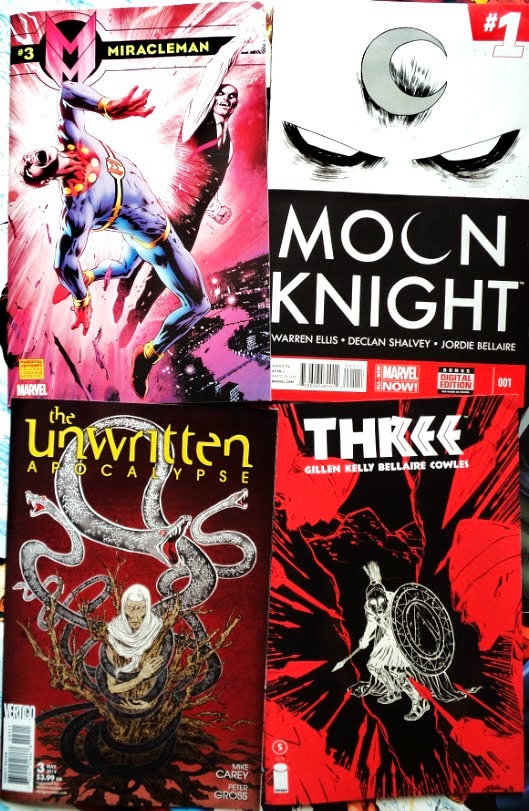When Mark Millar was writing The Ultimates (an alternative version of The Avengers) he turned Hank Pym into an abusive man, who tries to physically hurt Janet in a very shocking way. So obviously, the idea of a violent husband and a victimized woman has been a part of Millar’s stories for over a decade. In Empress, the Scottish writer gives a new spin to this familiar concept. There’s plenty of action in Millar’s proposal and some witty dialogs and interesting concepts.
Despite the good intentions, Empress seems to have more in common with recent Millar titles like Chrononauts than with his earlier and much more substantial works like Kick-Ass. In general, in the past couple of years, Millar seems to be restraining himself a little bit, putting a lot of effort into turning his stories into friendlier comics. That isn’t necessarily a bad thing, but in my opinion, the real Millar has a lot more to offer than inconsequential entertainment. It’s somewhat disappointing to see that this tendency is replicated in Reborn, Millar’s newest creation.
Nonetheless, the good thing is that Millar continues to work with some of the best artists in the industry. And in this particular case we’re talking about Stuart Immonen. The first time I saw Immonen’s drawings was in the pages of Adventures of Superman, back in the 90s. Even 20 years ago, he was already a magnificent artist. And one thing that always surprised me is that he kept improving. By the time he illustrated Superman: Secret Identity, he was definitely at the top of his game.
Since then, the Canadian penciler has worked on such diverse titles like X-Men or the newly revamped Star Wars titles. Inker Wade Von Grawbadger and colorist Ive Svorcina wonderfully complement Immonen’s art. Jesse Schedeen affirms that “The book thrives on the strength of the art team, as it delivers a cohesive space fantasy universe with just enough quirks to stand out from the crowd”, and I agree with him. So it’s with great joy and enthusiasm that I welcome Immonen’s work in Empress. He’s responsible for all the magic and the strong emotions that we can find in this Millarworld / Icon miniseries.
________________________________________________________________________________________________
________________________________________________________________________________________________
Por lo general, no vemos muchos cómics de superhéroes que se enfoquen en problemas maritales. Tal vez las aventuras de los aventureros enmascarados dejan poco espacio para esos asuntos domésticos. Por supuesto, este tema ha sido abordado antes, aunque brevemente. Hank Pym (el Ant-Man original) se convirtió en un sujeto que golpeaba a su novia en Avengers # 213 (noviembre, 1981). Aunque Jim Shooter se ha disculpado muchas veces por la escena brutal en la que Hank Pym (vestido como Yellow Jacket) golpea a su esposa Janet Van Dyne (The Wasp), sin duda ha permanecido como uno de los momentos más dramáticos de la historia de los Avengers.
Cuando Mark Millar escribía The Ultimates (una versión alternativa de The Avengers) convirtió a Hank Pym en un hombre abusivo, que trata de herir físicamente a Janet de una manera muy impactante. Así que, obviamente, la idea de un marido violento y una mujer victimizada ha sido parte de las historias de Millar durante más de una década. En Empress, el escritor escocés da una nueva vuelta de tuercas a este concepto familiar. Hay mucha acción en la propuesta de Millar y algunos diálogos ingeniosos y conceptos interesantes.
A pesar de las buenas intenciones, Empress parece tener más en común con ciertos títulos recientes de Millar como Chrononauts que con sus trabajos anteriores y mucho más sustanciales como Kick-Ass. En general, en los últimos años, Millar parece estar conteniéndose un poco, y poniendo mucho esfuerzo en transformar su narrativa en algo demasiado amigable. Eso no es necesariamente un defecto pero, en mi opinión, el verdadero Millar tiene mucho más que ofrecer que este tipo de entretenimiento irrelevante. Es ciertamente decepcionante ver que esta tendencia se replica en “Reborn”, la creación más reciente de Millar.
Sin embargo, lo bueno es que Millar sigue trabajando con algunos de los mejores artistas de la industria. Y en este caso en particular estamos hablando de Stuart Immonen. La primera vez que vi los dibujos de Immonen fue en las páginas de “Adventures of Superman”, en los 90s. Incluso hace 20 años, ya era un artista magnífico. Y una cosa que siempre me sorprendió es que siguió mejorando. Cuando ilustró Superman: Secret Identity, estaba definitivamente en su mejor momento.
Desde entonces, el dibujante canadiense ha trabajado en títulos tan diversos como X-Men o los recientemente renovados títulos de Star Wars. El entintador Wade Von Grawbadger y el colorista Ive Svorcina complementan maravillosamente el arte de Immonen. Jesse Schedeen afirma que “la colección prospera gracias a la fuerza del equipo artístico, ya que ofrece un universo de fantasía con bastantes elementos propios para destacar entre la multitud”, y estoy de acuerdo con él. Así es que con gran alegría y entusiasmo le doy la bienvenida a los lápices de Immonen. Él es responsable de toda la magia y las emociones fuertes que podemos encontrar en esta miniserie de Millarworld / Icon.











































